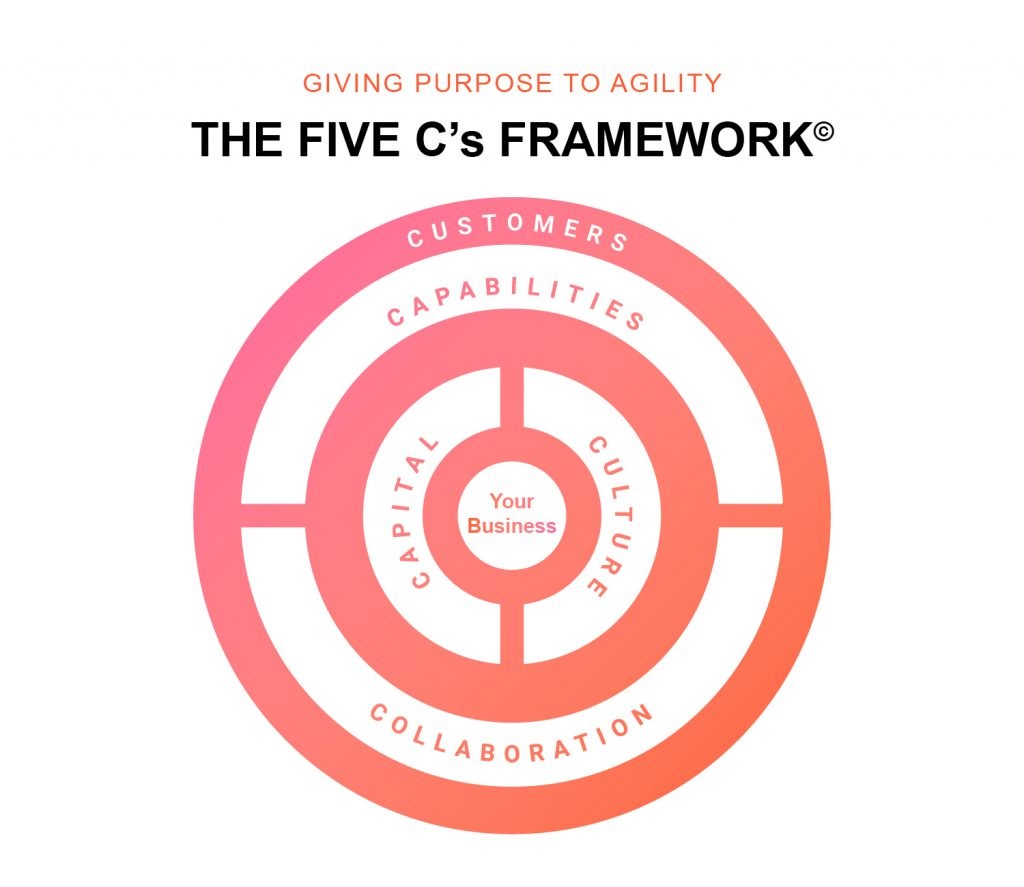The Five Cs Framework to Achieve Enterprise Agility

If you are a part of any large enterprise, you’ve likely talked about the need to be a more agile business, and for good reason: agile businesses continuously innovate and deliver impactful products at speed. However, talking about agility and becoming agile are two different things.
A recent Deloitte survey of more than 10,000 senior executives revealed that less than 10 percent of senior executives see their current organization as “highly agile today.” Yet more than 90 percent of those executives see “agility and collaboration” as critical to their firm’s success. (Similarly, McKinsey & Company reports that firms and units implementing agile do better financially than those that don’t.)

To address a future filled with ambiguity and change, enterprises must transform – and transformations are not easy. To help businesses close the gap between their aspirations and the reality of going agile, Moonshot has developed The Five Cs Framework for Enterprise Agility. The purpose of the framework is to give you a north star by identifying the five core elements of an agile business: culture, capital, capabilities, collaboration, and customers. Let’s take a closer look.
Culture: Empowering Teams to Own Journeys
Within a traditional corporate culture, people work in silos (such as marketing, finance, and HR) under hierarchies – an approach that slows down companies. No longer does it work for teams to be hierarchical or siloed. An agile culture rewards innovation and speed. And embracing this culture means changing how people work. Organizing people into cross-functional squads (a model derived from businesses such as Spotify) and empowering those squads to own the entire customer journey unleashes the power of an agile culture. The squads are built and disbanded depending on where the business needs to add value, so that they can move fast and be nimble.
Capital: Allocating Funds Dynamically
Agile transformation requires an adaptive way to fund innovative ideas. Most large organizations adhere to a process called entitlement funding, where budgets are defined and distributed on an annual cycle. But in an agile culture, a company cannot allocate once, wait 12 months, and then determine whether the project worked. The point of an agile culture is to rapidly test ideas, drop the ones that don’t work, and double-down on those that show promise. Entitlement funding is a slow and risky approach. A business risks allocating money to ideas that are not going to work and misses opportunities for ideas that quickly bubble to the surface and show promise.
Agile businesses rely on innovation accounting (i.e., metered funding). With innovation accounting (a concept used in the venture capital community), enterprises can take a more risk-averse approach to funding where capital is allocated on milestone-based sleeves to initiatives with market traction. This process allows the enterprise to reallocate budgets away from failing projects continuously within a calendar year.
Collaboration: Co-Creating with Customers and Stakeholders
Cross-functional squads should collaborate effectively by their nature. So why do we call out collaboration separately? The type of collaboration we’re talking about is co-creation with customers. Agile organizations involve customers in every step of the product development lifecycle. Through processes such as design sprints, a business develops a concept for a product that meets a customer need and pressure tests the concept against feedback from real customers. Ideas that show promise are developed into prototypes that we call Minimum Lovable Products, or the product that generates the maximum amount of customer love within the constraints of a business. Only by involving customers in product ideation can a business succeed in agile fashion. To scale beyond design sprints, we bring together design thinking and lean innovation into a broader methodology called FUEL.
Capabilities: Activating Intelligence with Velocity
An agile culture looks at capabilities differently. Capabilities exist for one purpose: to help a company move faster. Agile is about getting lovable products to market faster than your competition can. For capabilities to support an agile business, they need to be fueled by data and automation.
A company built on a foundation of strong data makes decisions faster. Automation expedites product development once you’ve made a decision. That’s why businesses need to build a culture of data centricity supported by software development tools such as DevOps that expedite product development in continuous fashion. Here’s how we see the relationships:
- Data-Centricity: the ability and awareness to extract meaningful insights to make decisions based on tangible results and findings.
- DevOps: the ability to automate and expedite the development lifecycle.
These crucial ingredients allow modern enterprises to make intelligent decisions and act on timely insights in a quick, nimble manner. This agility at scale is the ultimately enabled by the synchronization of the people, processes, and platforms in an agreed-upon collaboration framework.
Customer: The Heart of Agile Transformation
All companies like to say they focus on the customer. Agile organizations do by focusing on achieving fit – or finding opportunities to create magic moments for customers via lovable products. And they do so continuously, not just once or twice.
Continuously delivering value in an agile way starts with understanding the entire customer experience at each stage of the journey. Getting closer to the customer by translating those unmet and unrecognized needs opportunities into business value creates a pipeline of innovations. Establishing an innovation pipeline is the lifeblood for an organization to continuously grow and satisfy customers in new and engaging ways.
Get Started Today
The agile transformation journey is difficult but rewarding. Change is hard. When facing change, businesses that have a common language for what success looks like are better positioned to align their people around common goals of bringing that future to life. Use the Five C’s Framework today to continuously innovate and deliver impactful products at speed.
